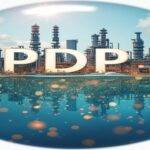
Providing PDP in Petrochemical and Refinery Units by APIPCO
آبان ۹, ۱۴۰۳
Carbon Dioxide (CO₂) Separation Using a New Method
آذر ۳, ۱۴۰۳Introduction
Process Design Package (PDP) includes a comprehensive set of documentation and technical information. which describes in detail all aspects of designing and implementing a specific industrial process. These documents are very important for engineers, contractor managers and project stakeholders and form a main reference for all activities and decisions related to the project.
And FEED also means basic engineering. which is done after completing the conceptual design or feasibility study. At this stage, before the start of EPC (Engineering, Procurement and Construction). various studies are carried out to find out the technical issues and estimate the initial investment costs. This is usually done as an optional contract or through tendering with EPC contractors. FEED work on a large project like LNG plant takes about 1 year. In fact, FEED or Front End Engineering Design is a part of the basic design of the process. which is a prerequisite for detailed design in many process units. In large process units, “FEED” plays an important role in the formation of detailed design.
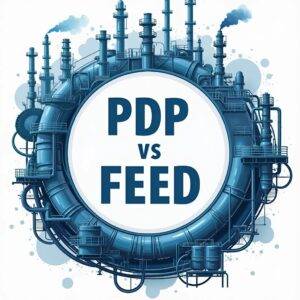
FEED
FEED is a preliminary engineering stage where engineers do the preliminary engineering diagram before doing the detailed design. This phase comes right after conceptual design but before detailed engineering drawings in project management. Various studies are conducted as part of FEED to determine the funding required for the project.
The task of carrying out this study is assigned to an EPC (Engineering, Procurement and Construction) contractor or a FEED consultant. However, in most cases, an EPC contractor conducts the FEED study, as the FEED is followed by the EPC phase. Therefore, the findings of the FEED, known as the FEED package, are also necessary for the award of the EPC contract.
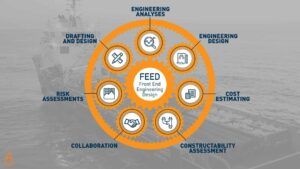
PDP
In fact, in general, the process design package (PDP: PROCESS DESIGN PACKAGE) means the activities to provide diagrams and documents related to design and construction by the technology provider, including:
Basic design data
process flow diagram (PDP)
Piping and Instrumentation Diagram (P&ID)
Equipment process information sheet + equipment list
List of laboratory equipment
Interlock description
Factory layout and overall equipment layout
Safety design criteria
List of fluids and piping class
Instrument requirements
Required Inputs and FEED Products
The accuracy of the FEED project depends on the inputs provided to the FEED engineering contractor. The engineering team conducting the FEED requires various inputs for a successful FEED study. This includes:
Engineering scope of work, feasibility study report, project site details, operational standards and guidelines details, client’s technical practices
FEED deliverables include various outputs that Front End Engineering Design provides at the end of the study.
Final plot design
Tool and valve data sheets
MDS (Mechanical Data Sheet)
P&ID (Piping and Instrumentation Diagram)
General arrangement drawings of main equipment and main piping.
Cost estimate
line list
HAZOP report
Project implementation plan, HSE plan
operational philosophy
Components and Details of The Process Design Package (PDP)
1. General description of the process
Purpose and scope, overall performance, market and needs analysis
2. Process diagrams
Process Flow Diagram (PFD), Control Diagram (P&ID)
3. Definition of equipment
Description of equipment, introduction of manufacturers
4. Operational specifications
Environmental conditions, control function
5. Materials and construction materials
Material selection, material test reports
6. Safety and environmental analysis
Hazard analysis and risk assessment (HAZOP), environmental impact study
7. Engineering calculations
Thermal calculations and mass balance, computer simulation
8. Cost estimation
Analysis of operational costs, financial plans
9. How to test and launch
Test and setup program, performance test
10. Documentation and maintenance
Maintenance and repair documents, educational documents
Application of FEED in Industries
Front-end engineering design is used in various industries, especially before the start-up of production facilities. Here are the departments that use FEED at different stages of their programs.
Construction
oil and gas
Automation
Chemical processing
Process industry production
EPC
EPCIC
Equipment design
Process system design
Pharmacy
Petrochemicals
refinement
Production line design
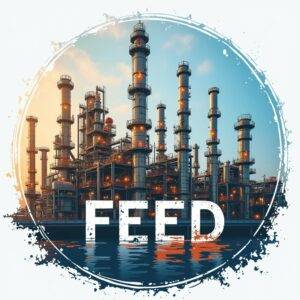
PDP (Project Development Planning)
Project development planning (PDP) generally includes the following steps:
– Definition of goals and needs: In this step, project goals, market needs, and legal and environmental requirements are defined. Technical and economic analysis: review and technical and economic analysis of proposed plans to ensure feasibility and profitability.
Preliminary studies: including preliminary technical reviews, evaluation of sources and raw materials and anticipation of possible challenges. Risk assessment: recognition and assessment of project risks, including financial, technical and environmental risks.
Market analysis: examining market needs and forecasting demand for final products.
Investment planning: estimating the necessary capital and developing a schedule for financing.
FEED (Preliminary Engineering Design)
Preliminary Engineering Design (FEED) is the phase that defines the details of the project before the implementation phase and includes the following:
Compilation of technical specifications: preparation of technical documentation including product specifications, technologies used, and required systems.
Detailed design: including simplified diagrams (P&ID), equipment layout and necessary specifications for the facility.
Cost Analysis: Determining more accurate costs for the project and preparing financial forecasts.
Risk management: At this stage, risk management strategies are anticipated to compensate for possible problems.
Schedule: Establishing a more accurate schedule for project execution stages and facility related works.
Safety and standards compliance: reviewing and implementing safety standards and compliance with relevant laws
Operators and Benefits
Creating transparency: PDP and FEED make clear and document all stages and weaknesses and strengths of the project.
Risk reduction: crises can be prevented by better understanding the risks and possible problems.
Optimization of resources: they seek to optimize the use of financial and human resources and help reduce project costs.
Increasing the probability of success: With comprehensive and detailed design, the probability of success of innovative projects increases.
Providing PDP and FEED For Innovative and New Projects in The Petrochemical Oil and Gas Industry
In the petrochemical industry, due to the need for continuous improvement and compliance with environmental, economic and social requirements, innovative and new designs play a key role in the PDP (Process Design Package) and FEED (Preliminary Engineering Design) stages. Below are some of these plans and innovations:
1. Green and Stable Processes
– Design of catalytic processes: the use of new and optimal catalysts to reduce the temperature and pressure of operation, leads to less energy consumption and reduction of production waste.
– Use of renewable raw materials: strengthening efforts to produce petrochemical raw materials from biological sources (such as biodiesel and natural fibers) instead of fossil sources.
2. Advanced Control
– Implementing systems to monitor equipment performance and optimize energy and material consumption in real time.
– Data management systems: using advanced analytics and artificial intelligence to process data related to process performance and identify optimal patterns.
3. Capacity Building and Digital Modeling
– Digital modeling and simulation: creating detailed simulation models of processes in order to analyze and optimize performance, identify weak points and suggest corrections.
– (VR and AR): using virtual and augmented reality technologies to train employees and analyze processes interactively.
4. Designing Modern Processes to Reduce Energy Consumption
– Low temperature and pressure: Sometimes designing processes that work with lower temperature and pressure leads to saving energy and costs.
– Recycled thermal systems: optimizing the design of thermal and refrigeration systems for the reuse of waste heat.
5. Development of New and Special Products
– Specialized and combined polymers: designing processes to produce polymers with specific and functional properties in order to respond to the specialized needs of the market.
– Biological products: production of biological products that are environmentally compatible and with the least negative effects.
6. Waste Management and Removal Plans
– Waste decomposition and recycling: designing recycling processes to reuse petrochemical waste materials and reduce waste production.
– Use of chemical techniques for reconstruction: creation of new chemical methods to recover the details obtained from the processes.
7. Enhanced Safety and Environmental Standards
– (Safety By Design): designing processes and equipment in such a way that safety is maintained at a high level. This includes safety simulations and risk assessments.
– Advanced pollution reduction methods: applying innovative methods to control and reduce pollution caused by petrochemical operations.
8. Energy Management and Saving Resources
– Energy management systems: implementation of management systems to monitor, control and optimize energy consumption in units.
– Use of renewable energy: Investigating the possibility of using solar and wind energy to supply the required energy of a petrochemical unit.
List of FEED Projects Carried Out by APIPCO
Innovative Syngas and Methanol Process vs Marjan Pet. Co. Method
Design of Technical Knowledge Diagrams for Sorbitan Production
Conclusion
New designs in the PDP and FEED stages in the petrochemical industry have the ability to direct the processes towards sustainability, efficiency and cost reduction. By using advanced technologies, new designs and paying attention to environmental considerations, economic and environmental goals can be achieved in these industries. The implementation of these innovations requires cooperation between different disciplines, the use of new technologies and intelligent management of resources.
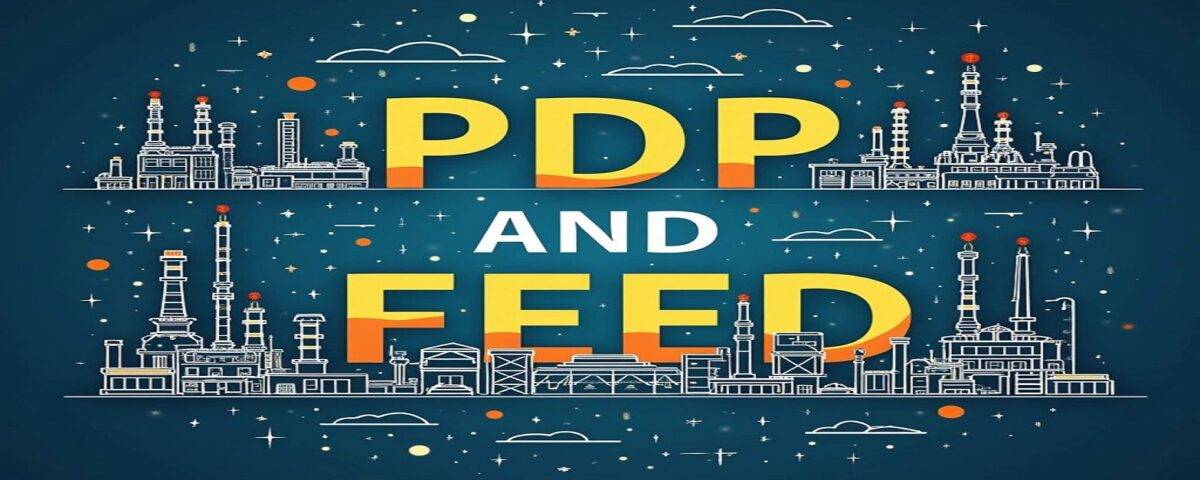
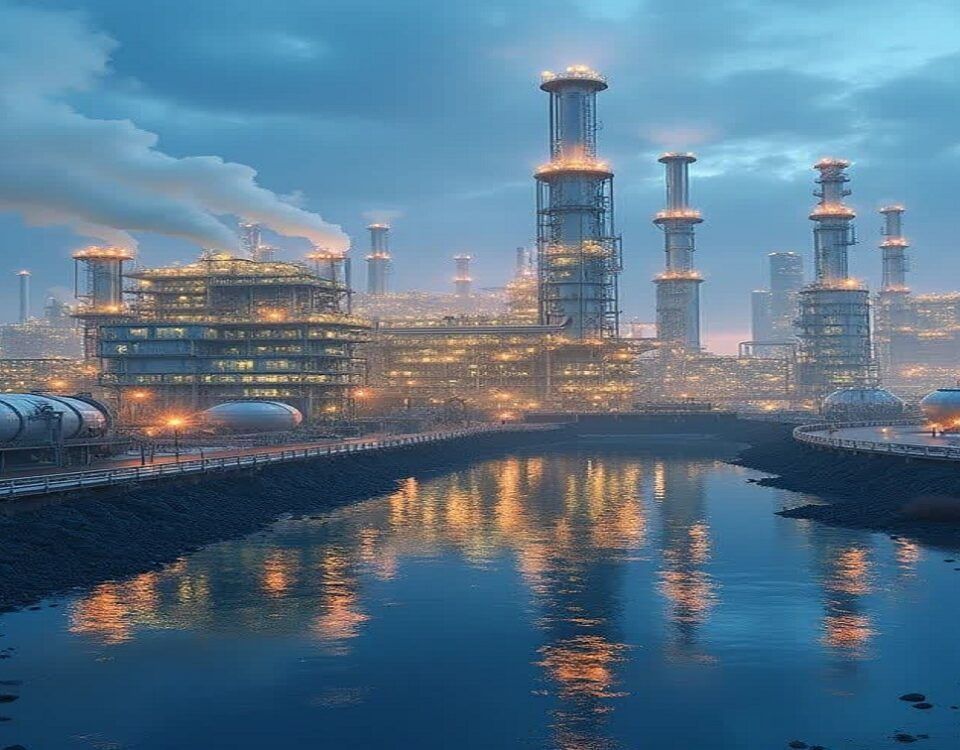
2 Comments
What is the importance of PDP and FEED services in innovative petrochemical projects?
hello
In fact, PDP and FEED in the petrochemical industry have the ability to direct products towards sustainability, efficiency and cost reduction. It is also possible to achieve economic and environmental goals in these industries.